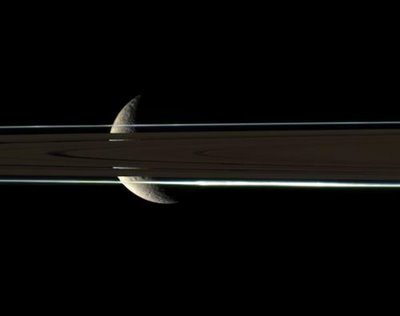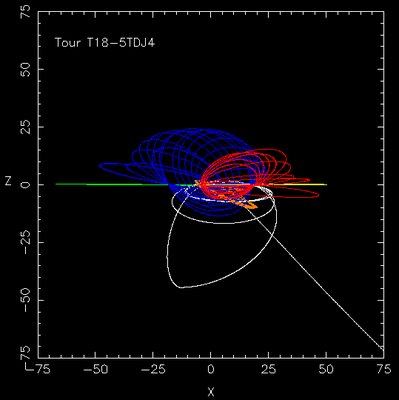Thursday, August 10, 2006
Saturnian Sights
Some recently posted color images from the Cassini web page. First, Rhea (about 950 miles across) behind the shadow side of Saturn's rings:
 And we have the potato-shaped Hyperion, about the size and shape of West Virginia, tan instead of gray:
And we have the potato-shaped Hyperion, about the size and shape of West Virginia, tan instead of gray:
 Is it tan because of dark material dusted from outer moons like Iapetus or Phoebe? And why is Hyperion so much larger than the solar system's next-largest non-spherical moon? Only the Creator knows for sure.
I blogged on this thought months ago, but Hyperion would be an excellent site for space spelunking. It must contain empty spaces for a moon as large as it is to weigh as little as it does. You might ask: how do we know how much these moons weigh? By measuring small deviations in Cassini's flight path as it passes near them. Gravity bends a flight path, and the more bend, the more mass a celestial body possesses.
Mission planners are able to use repeated fly-bys of the large moon Titan to alter the probe's orbital path around Saturn. Diagrams of the mission plan are here and here:
Is it tan because of dark material dusted from outer moons like Iapetus or Phoebe? And why is Hyperion so much larger than the solar system's next-largest non-spherical moon? Only the Creator knows for sure.
I blogged on this thought months ago, but Hyperion would be an excellent site for space spelunking. It must contain empty spaces for a moon as large as it is to weigh as little as it does. You might ask: how do we know how much these moons weigh? By measuring small deviations in Cassini's flight path as it passes near them. Gravity bends a flight path, and the more bend, the more mass a celestial body possesses.
Mission planners are able to use repeated fly-bys of the large moon Titan to alter the probe's orbital path around Saturn. Diagrams of the mission plan are here and here:
 If we were watching Cassini from high above Saturn's north pole, this is how the probe's seventy-six planned orbits would appear. White shows the first few orbits. Cassini has just moved from the "green" phase to the "blue" phase, which shifts the orbit from an outswing on the "left" to the "upper right." Repeated maneuvers near Titan moves the orbital path so scientists can study different aspects of the Saturn neighborhood. The green orbits looks like flower petals, so the phase is termed "Petal Rotation and Magnetotail Petal" permitting study of Saturn's magnetic field from different angles with respect to the sun.
The blue orbits are the current phase, "Titan 180 Transfer," which flips the spacecraft on the other side of the planet for closest approach, and permits close-up images of areas of the moons which may have been in darkness on the
If we were watching Cassini from high above Saturn's north pole, this is how the probe's seventy-six planned orbits would appear. White shows the first few orbits. Cassini has just moved from the "green" phase to the "blue" phase, which shifts the orbit from an outswing on the "left" to the "upper right." Repeated maneuvers near Titan moves the orbital path so scientists can study different aspects of the Saturn neighborhood. The green orbits looks like flower petals, so the phase is termed "Petal Rotation and Magnetotail Petal" permitting study of Saturn's magnetic field from different angles with respect to the sun.
The blue orbits are the current phase, "Titan 180 Transfer," which flips the spacecraft on the other side of the planet for closest approach, and permits close-up images of areas of the moons which may have been in darkness on the other side of the planet. Why is that? Saturn's gravity is so strong that all of the moons are tidally locked in rotation. Like our moon, one side of them always faces Saturn. If Cassini stayed in the same orbit, it would get close looks at the same sunlit sides of the inner moons.
Edge on, the Cassini plan looks like this diagram on the right:
Note that the petal phase kept the probe flying over Saturn's equator. The transfer phase will give the probe new perspectives of the rings as it flies at an angle with respect to them.
Just so you know, the time sequence of the colors is white, orange, green, blue, yellow, red: the four-year mission.
other side of the planet. Why is that? Saturn's gravity is so strong that all of the moons are tidally locked in rotation. Like our moon, one side of them always faces Saturn. If Cassini stayed in the same orbit, it would get close looks at the same sunlit sides of the inner moons.
Edge on, the Cassini plan looks like this diagram on the right:
Note that the petal phase kept the probe flying over Saturn's equator. The transfer phase will give the probe new perspectives of the rings as it flies at an angle with respect to them.
Just so you know, the time sequence of the colors is white, orange, green, blue, yellow, red: the four-year mission.